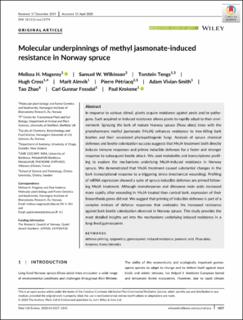| dc.contributor.author | Magerøy, Melissa | |
| dc.contributor.author | Wilkinson, Samuel W. | |
| dc.contributor.author | Tengs, Torstein | |
| dc.contributor.author | Cross, Hugh | |
| dc.contributor.author | Almvik, Marit | |
| dc.contributor.author | Petriacq, Pierre | |
| dc.contributor.author | Vivian-Smith, Adam | |
| dc.contributor.author | Zhao, Tao | |
| dc.contributor.author | Fossdal, Carl Gunnar | |
| dc.contributor.author | Krokene, Paal | |
| dc.date.accessioned | 2020-11-09T09:44:07Z | |
| dc.date.available | 2020-11-09T09:44:07Z | |
| dc.date.created | 2020-05-11T12:17:53Z | |
| dc.date.issued | 2020-04-22 | |
| dc.identifier.citation | Plant, Cell and Environment. 2020, 43 (8), 1827-1843. | en_US |
| dc.identifier.issn | 0140-7791 | |
| dc.identifier.uri | https://hdl.handle.net/11250/2686888 | |
| dc.description.abstract | In response to various stimuli, plants acquire resistance against pests and/or pathogens. Such acquired or induced resistance allows plants to rapidly adapt to their environment. Spraying the bark of mature Norway spruce (Picea abies) trees with the phytohormone methyl jasmonate (MeJA) enhances resistance to tree‐killing bark beetles and their associated phytopathogenic fungi. Analysis of spruce chemical defenses and beetle colonization success suggests that MeJA treatment both directly induces immune responses and primes inducible defenses for a faster and stronger response to subsequent beetle attack. We used metabolite and transcriptome profiling to explore the mechanisms underlying MeJA‐induced resistance in Norway spruce. We demonstrated that MeJA treatment caused substantial changes in the bark transcriptional response to a triggering stress (mechanical wounding). Profiling of mRNA expression showed a suite of spruce inducible defenses are primed following MeJA treatment. Although monoterpenes and diterpene resin acids increased more rapidly after wounding in MeJA‐treated than control bark, expression of their biosynthesis genes did not. We suggest that priming of inducible defenses is part of a complex mixture of defense responses that underpins the increased resistance against bark beetle colonization observed in Norway spruce. This study provides the most detailed insights yet into the mechanisms underlying induced resistance in a long‐lived gymnosperm. | en_US |
| dc.language.iso | eng | en_US |
| dc.publisher | John Wiley & Sons Ltd. | en_US |
| dc.rights | Attribution-NonCommercial-NoDerivatives 4.0 Internasjonal | * |
| dc.rights.uri | http://creativecommons.org/licenses/by-nc-nd/4.0/deed.no | * |
| dc.title | Molecular underpinnings of methyl jasmonate‐induced resistance in Norway spruce | en_US |
| dc.type | Peer reviewed | en_US |
| dc.type | Journal article | en_US |
| dc.description.version | publishedVersion | en_US |
| dc.rights.holder | © 2020 The Authors | en_US |
| dc.source.pagenumber | 1827-1843 | en_US |
| dc.source.volume | 43 | en_US |
| dc.source.journal | Plant, Cell and Environment | en_US |
| dc.source.issue | 8 | en_US |
| dc.identifier.doi | 10.1111/pce.13774 | |
| dc.identifier.cristin | 1810250 | |
| dc.relation.project | Norges forskningsråd: 249920 | en_US |
| dc.relation.project | Norges forskningsråd: 249958 | en_US |
| cristin.ispublished | true | |
| cristin.fulltext | original | |
| cristin.qualitycode | 2 | |

